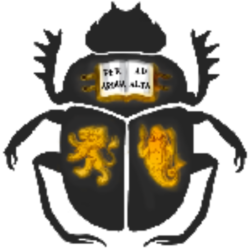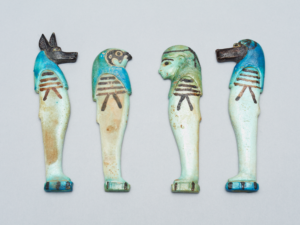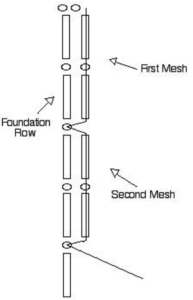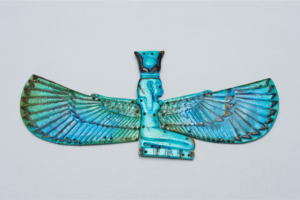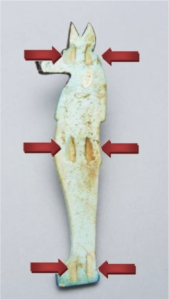The Four Sons of Horus
Guardians of the Dead
Sarah Chapman
These four amulets represent a group of mummiform funerary gods known as the four sons of Horus. Alternatively, this group of deities is also referred to as the children of Horus. The four sons of Horus were minor gods (called genii) who were believed to have acted as assistant embalmers to Anubis, the patron deity of mummification. They include the jackal-headed Duamutef (ECM 1593), falcon-headed Qebehsenuef (ECM 1594), human-headed Imseti (ECM 1595), and ape-headed Hapi (ECM 1596).
These amulets would originally been attached to a bead-net funerary shroud. All four of the amulets were moulded out of solid faience and have broad collar, stole, and base outlined in black. Three of these (Duamutef, Qebehsenuef, and Hapi) have a blue tripartite wig and base, while Imseti’s tripartite wig and base are green. Hapi and Duamutef have black faces and Qebehsenuef and Imseti have blue faces with details outlined in black. The dimensions of each of the amulets are as follows:
| Amulet | Dimensions (Height x Width x Depth) |
| Duamutef | 15.70 cm x 4.31 cm x 0.89 cm |
| Hapi | 14.69 cm x 4.59 cm x 0.98 cm |
| Imseti | 14.35 cm x 4.08 cm x 0.72 cm |
| Qebehsenuef | 13.91 cm x 3.78 cm x 0.81 cm |
Bead-net mummy coverings were first introduced in the Third Intermediate Period (1069-664 BC). These nets were created by weaving thread through a sequence of small tube and disc-beads. Initially they are kept very plain, consisting only of blue faience beads. By the late Twenty-Fifth Dynasty (747-656 BC), solid faience amulets were incorporated into bead-nets. These typically included a human face, a winged scarab, winged goddesses Isis and Nephthys, and the four sons of Horus.[1]
The four sons of Horus amulets from the Eton Myers Collection are much larger and more ornate than the typical solid faience amulets of bead-net shrouds. Frequently, bead-net amulets are small and roughly formed. Another bead-net amulet equal in size and detail held in the Eton Myers Collection is the Nut Mummy Amulet (ECM 1478), which comes from the same mummy as the four sons of Horus amulets in the collection as well as a winged scarab in the Eton Myers collection in Baltimore. Based on the style and shape of this collection of amulets, they have been dated to the early Third Intermediate Period (1069-945 BC).[2]
|
|
Faience amulets were attached to bead-net shrouds by threading string through holes that were pierced in the amulets before the faience was fired. Large bead-net amulets, such as those in the Eton Myers Collection, required a number of holes in order to securely sew them into the network of beads. The four sons of Horus amulets each have three holes pierced into their backs.
|
|
The four sons of Horus amulets were attached near the centre of the bead-net so that they would rest directly above the mummy’s abdomen. This was reflective of the primary function of these deities as protectors of the internal organs of the deceased. Each of these gods was responsible for the protection of a specific organ:
| Protective Deity | Organ |
| Duamutef (jackal) | Stomach |
| Qebehsenuef (falcon) | Intestines |
| Imseti (human) | Liver |
| Hapi (ape) | Lungs |
[expand title=”Endnotes”]
[1] For a bead-net typology, see Flora, 1980.
[2] Spurr, et al. 1999: 43. Two identical sets of amulets dating to the same period can be found in Berlin (Inv. Nos. 12629-12634) and in the British Museum (BM EA 26228-26230).
[/expand]
[expand title=”Bibliography and Further Reading”]
Silvano, F. 1980. “‘Le Reticelle Funerarie Nell’ Antico Egitto: Proposte di Interpretazione,” Egitto e Vicino Oriente 3, 83-95.
Spurr, S., Reeves, N., and Quirke, S. 1999. Egyptian Art at Eton College: Selections from the Myers Museum. Windsor and New York.
[/expand]
